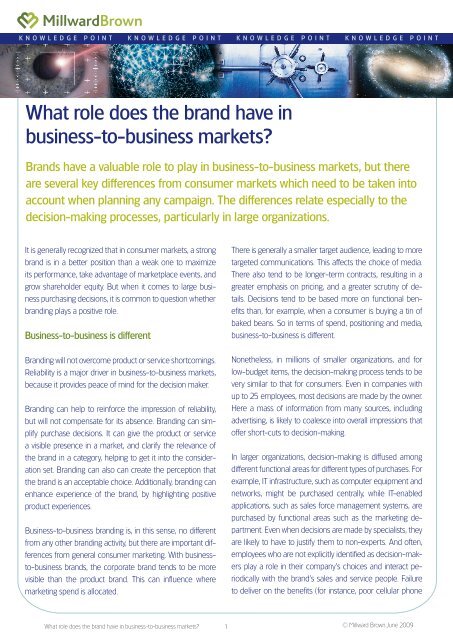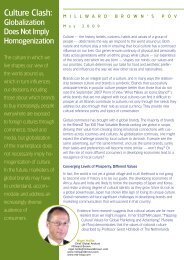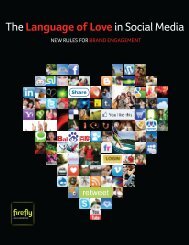What role does the brand have in business-to ... - ARMI - Marketing
What role does the brand have in business-to ... - ARMI - Marketing
What role does the brand have in business-to ... - ARMI - Marketing
Create successful ePaper yourself
Turn your PDF publications into a flip-book with our unique Google optimized e-Paper software.
K N O W L E D G E P O I N T K N O W L E D G E P O I N T K N O W L E D G E P O I N T K N O W L E D G E P O I N T<br />
<strong>What</strong> <strong>role</strong> <strong>does</strong> <strong>the</strong> <strong>brand</strong> <strong>have</strong> <strong>in</strong><br />
bus<strong>in</strong>ess-<strong>to</strong>-bus<strong>in</strong>ess markets?<br />
Brands <strong>have</strong> a valuable <strong>role</strong> <strong>to</strong> play <strong>in</strong> bus<strong>in</strong>ess-<strong>to</strong>-bus<strong>in</strong>ess markets, but <strong>the</strong>re<br />
are several key differences from consumer markets which need <strong>to</strong> be taken <strong>in</strong><strong>to</strong><br />
account when plann<strong>in</strong>g any campaign. The differences relate especially <strong>to</strong> <strong>the</strong><br />
decision-mak<strong>in</strong>g processes, particularly <strong>in</strong> large organizations.<br />
It is generally recognized that <strong>in</strong> consumer markets, a strong<br />
<strong>brand</strong> is <strong>in</strong> a better position than a weak one <strong>to</strong> maximize<br />
its performance, take advantage of marketplace events, and<br />
grow shareholder equity. But when it comes <strong>to</strong> large bus<strong>in</strong>ess<br />
purchas<strong>in</strong>g decisions, it is common <strong>to</strong> question whe<strong>the</strong>r<br />
<strong>brand</strong><strong>in</strong>g plays a positive <strong>role</strong>.<br />
Bus<strong>in</strong>ess-<strong>to</strong>-bus<strong>in</strong>ess is different<br />
There is generally a smaller target audience, lead<strong>in</strong>g <strong>to</strong> more<br />
targeted communications. This affects <strong>the</strong> choice of media.<br />
There also tend <strong>to</strong> be longer-term contracts, result<strong>in</strong>g <strong>in</strong> a<br />
greater emphasis on pric<strong>in</strong>g, and a greater scrut<strong>in</strong>y of details.<br />
Decisions tend <strong>to</strong> be based more on functional benefits<br />
than, for example, when a consumer is buy<strong>in</strong>g a t<strong>in</strong> of<br />
baked beans. So <strong>in</strong> terms of spend, position<strong>in</strong>g and media,<br />
bus<strong>in</strong>ess-<strong>to</strong>-bus<strong>in</strong>ess is different.<br />
Brand<strong>in</strong>g will not overcome product or service shortcom<strong>in</strong>gs.<br />
Reliability is a major driver <strong>in</strong> bus<strong>in</strong>ess-<strong>to</strong>-bus<strong>in</strong>ess markets,<br />
because it provides peace of m<strong>in</strong>d for <strong>the</strong> decision maker.<br />
Brand<strong>in</strong>g can help <strong>to</strong> re<strong>in</strong>force <strong>the</strong> impression of reliability,<br />
but will not compensate for its absence. Brand<strong>in</strong>g can simplify<br />
purchase decisions. It can give <strong>the</strong> product or service<br />
a visible presence <strong>in</strong> a market, and clarify <strong>the</strong> relevance of<br />
<strong>the</strong> <strong>brand</strong> <strong>in</strong> a category, help<strong>in</strong>g <strong>to</strong> get it <strong>in</strong><strong>to</strong> <strong>the</strong> consideration<br />
set. Brand<strong>in</strong>g can also can create <strong>the</strong> perception that<br />
<strong>the</strong> <strong>brand</strong> is an acceptable choice. Additionally, <strong>brand</strong><strong>in</strong>g can<br />
enhance experience of <strong>the</strong> <strong>brand</strong>, by highlight<strong>in</strong>g positive<br />
product experiences.<br />
Bus<strong>in</strong>ess-<strong>to</strong>-bus<strong>in</strong>ess <strong>brand</strong><strong>in</strong>g is, <strong>in</strong> this sense, no different<br />
from any o<strong>the</strong>r <strong>brand</strong><strong>in</strong>g activity, but <strong>the</strong>re are important differences<br />
from general consumer market<strong>in</strong>g. With bus<strong>in</strong>ess<strong>to</strong>-bus<strong>in</strong>ess<br />
<strong>brand</strong>s, <strong>the</strong> corporate <strong>brand</strong> tends <strong>to</strong> be more<br />
visible than <strong>the</strong> product <strong>brand</strong>. This can <strong>in</strong>fluence where<br />
market<strong>in</strong>g spend is allocated.<br />
None<strong>the</strong>less, <strong>in</strong> millions of smaller organizations, and for<br />
low-budget items, <strong>the</strong> decision-mak<strong>in</strong>g process tends <strong>to</strong> be<br />
very similar <strong>to</strong> that for consumers. Even <strong>in</strong> companies with<br />
up <strong>to</strong> 25 employees, most decisions are made by <strong>the</strong> owner.<br />
Here a mass of <strong>in</strong>formation from many sources, <strong>in</strong>clud<strong>in</strong>g<br />
advertis<strong>in</strong>g, is likely <strong>to</strong> coalesce <strong>in</strong><strong>to</strong> overall impressions that<br />
offer short-cuts <strong>to</strong> decision-mak<strong>in</strong>g.<br />
In larger organizations, decision-mak<strong>in</strong>g is diffused among<br />
different functional areas for different types of purchases. For<br />
example, IT <strong>in</strong>frastructure, such as computer equipment and<br />
networks, might be purchased centrally, while IT-enabled<br />
applications, such as sales force management systems, are<br />
purchased by functional areas such as <strong>the</strong> market<strong>in</strong>g department.<br />
Even when decisions are made by specialists, <strong>the</strong>y<br />
are likely <strong>to</strong> <strong>have</strong> <strong>to</strong> justify <strong>the</strong>m <strong>to</strong> non-experts. And often,<br />
employees who are not explicitly identified as decision-makers<br />
play a <strong>role</strong> <strong>in</strong> <strong>the</strong>ir company’s choices and <strong>in</strong>teract periodically<br />
with <strong>the</strong> <strong>brand</strong>’s sales and service people. Failure<br />
<strong>to</strong> deliver on <strong>the</strong> benefits (for <strong>in</strong>stance, poor cellular phone<br />
<strong>What</strong> <strong>role</strong> <strong>does</strong> <strong>the</strong> <strong>brand</strong> <strong>have</strong> <strong>in</strong> bus<strong>in</strong>ess-<strong>to</strong>-bus<strong>in</strong>ess markets? 1<br />
© Millward Brown June 2009
K N O W L E D G E P O I N T K N O W L E D G E P O I N T K N O W L E D G E P O I N T K N O W L E D G E P O I N T<br />
performance) filters up through compla<strong>in</strong>ts and can eventually<br />
lead <strong>to</strong> a change of vendor. So even <strong>in</strong> large organizations,<br />
<strong>the</strong> views of non-specialists can be important.<br />
80<br />
Relationship between satisfaction and consideration is not direct<br />
£15 – 250 million turnover<br />
The drivers of decision-mak<strong>in</strong>g<br />
For service <strong>brand</strong>s, <strong>the</strong>re are massive differences <strong>in</strong> <strong>the</strong> drivers<br />
of <strong>brand</strong> health between users (for whom <strong>the</strong>ir experience<br />
of us<strong>in</strong>g <strong>the</strong> <strong>brand</strong> is key) and non-users (who will<br />
be more reliant on communications). The extent <strong>to</strong> which<br />
<strong>in</strong>dividuals work<strong>in</strong>g for <strong>the</strong> <strong>brand</strong> are able <strong>to</strong> build relationships<br />
with <strong>the</strong>ir cus<strong>to</strong>mers and put <strong>to</strong>ge<strong>the</strong>r advantageously<br />
priced packages can often be crucial <strong>in</strong> bond<strong>in</strong>g cus<strong>to</strong>mers<br />
<strong>to</strong> <strong>the</strong> <strong>brand</strong>s <strong>the</strong>y use. There is naturally also a vital requirement<br />
for <strong>the</strong> right products or services, and sufficient capability<br />
<strong>to</strong> deliver what cus<strong>to</strong>mers need (at <strong>the</strong> right scale and<br />
over <strong>the</strong> right geographical area) <strong>in</strong> order for people <strong>to</strong> put<br />
<strong>to</strong>ge<strong>the</strong>r <strong>the</strong> right packages or deals.<br />
Professional bus<strong>in</strong>ess cus<strong>to</strong>mers are generally more focused<br />
on functional benefits than smaller bus<strong>in</strong>esses and consumers,<br />
and this bias grows with <strong>the</strong> size of <strong>the</strong> organization. In<br />
one f<strong>in</strong>ancial market, <strong>the</strong> average “first-choice” consideration<br />
score for cus<strong>to</strong>mers for <strong>the</strong>ir current supllier averages at 63<br />
percent for bus<strong>in</strong>esses turn<strong>in</strong>g over under £1 million a year,<br />
but falls <strong>to</strong> 52 percent for those turn<strong>in</strong>g over more than £15<br />
million. Similarly, <strong>the</strong> relationship between satisfaction with<br />
current experience and first-choice consideration is not direct.<br />
In larger organizations <strong>the</strong>re is less commitment <strong>to</strong> current<br />
suppliers and more will<strong>in</strong>gness <strong>to</strong> explore alternatives.<br />
There are many fac<strong>to</strong>rs at play here. The needs of larger<br />
companies are more complex, and <strong>the</strong>y are more likely <strong>to</strong>,<br />
First choice consideration<br />
70<br />
60<br />
50<br />
40<br />
40<br />
50 60 70 80<br />
Overall satisfaction<br />
for example, use more than one bank. In larger organizations,<br />
<strong>the</strong>re is an <strong>in</strong>creas<strong>in</strong>g disconnect between <strong>the</strong> user of<br />
<strong>the</strong> product or service, and <strong>the</strong> decision-maker(s). There<br />
is also a tendency for <strong>the</strong> number of decision-makers <strong>to</strong><br />
<strong>in</strong>crease: Major decisions need <strong>to</strong> be ratified by a number<br />
of people. In <strong>the</strong>se situations, <strong>the</strong> decision-makers are<br />
more likely <strong>to</strong> try <strong>to</strong> make choices based on needs, and <strong>the</strong><br />
deals and capabilities offered by each compet<strong>in</strong>g supplier.<br />
It is <strong>the</strong>se processes that weaken <strong>the</strong> relationship between<br />
consideration and satisfaction.<br />
But even where we might assume that functional benefits<br />
determ<strong>in</strong>e <strong>brand</strong> choice, o<strong>the</strong>r fac<strong>to</strong>rs are still important.<br />
We can take an example from what is often assumed <strong>to</strong><br />
be a highly functionally driven market, <strong>the</strong> pharmaceutical<br />
<strong>in</strong>dustry. Loyalty <strong>to</strong> <strong>brand</strong>s among specialists is not solely<br />
driven by price and functional elements, and <strong>in</strong> one particular<br />
market with little product differentiation, loyalty is<br />
driven by popularity at a particularly high level.<br />
<strong>What</strong> <strong>role</strong> <strong>does</strong> <strong>the</strong> <strong>brand</strong> <strong>have</strong> <strong>in</strong> bus<strong>in</strong>ess-<strong>to</strong>-bus<strong>in</strong>ess markets?<br />
2 © Millward Brown June 2009
K N O W L E D G E P O I N T K N O W L E D G E P O I N T K N O W L E D G E P O I N T K N O W L E D G E P O I N T<br />
For pharmaceutical <strong>brand</strong>s, loyalty is not solely driven by rational fac<strong>to</strong>rs<br />
Loyalty drivers<br />
All Pharmaceutical <strong>brand</strong>s<br />
Emotional 18%<br />
Popularity 26%<br />
Rational 16%<br />
Difference 12%<br />
Price 14%<br />
Innovation 14%<br />
c. 500 <strong>brand</strong>s<br />
Pharma market with little differentiation<br />
Emotional 16%<br />
Popularity 49%<br />
Rational 9%<br />
Price 5%<br />
Innovation 8%<br />
Difference 13%<br />
6 <strong>brand</strong>s<br />
One additional fac<strong>to</strong>r affects <strong>brand</strong>s that straddle <strong>the</strong> consumer<br />
and bus<strong>in</strong>ess-<strong>to</strong>-bus<strong>in</strong>ess environments. The reputation<br />
of a <strong>brand</strong> <strong>in</strong> one sec<strong>to</strong>r is likely <strong>to</strong> <strong>in</strong>fluence its reputation<br />
<strong>in</strong> <strong>the</strong> o<strong>the</strong>r. One telecoms company had a poor<br />
reputation for its consumer service. Ads for its bus<strong>in</strong>ess<br />
products and services were treated with a lot of skepticism<br />
because bus<strong>in</strong>ess professionals did not believe <strong>the</strong> company<br />
could deliver <strong>in</strong> <strong>the</strong> bus<strong>in</strong>ess environment ei<strong>the</strong>r.<br />
The value of a strong <strong>brand</strong><br />
Brand<strong>in</strong>g can <strong>in</strong>fluence bus<strong>in</strong>ess-<strong>to</strong>-bus<strong>in</strong>ess decisions. A<br />
good example is IBM <strong>in</strong> <strong>the</strong> United States, where it holds<br />
a strong position <strong>in</strong> <strong>the</strong> bus<strong>in</strong>ess IT solutions market. The<br />
Brand Pyramid below (derived from <strong>the</strong> WPP BrandZ<br />
study), is a healthy one. Its level of Presence <strong>in</strong> <strong>the</strong> market is<br />
strong (85 percent), and <strong>the</strong> Signature on <strong>the</strong> right (show<strong>in</strong>g<br />
how well <strong>the</strong> <strong>brand</strong> moves up from one level of equity<br />
<strong>to</strong> ano<strong>the</strong>r) shows that <strong>the</strong> extent <strong>to</strong> which consumers are<br />
attitud<strong>in</strong>ally bonded <strong>to</strong> it is strong.<br />
IBM – healthy <strong>in</strong> <strong>the</strong> Bus<strong>in</strong>ess IT solutions market<br />
IT Solutions (bus<strong>in</strong>ess) - USA - 2007<br />
As ano<strong>the</strong>r example, technology firms are <strong>in</strong>creas<strong>in</strong>gly realiz<strong>in</strong>g<br />
that design is important: How <strong>the</strong> product looks and<br />
feels can drive perceptions of functionality and <strong>in</strong>novation.<br />
Bond<strong>in</strong>g<br />
Advantage<br />
IBM<br />
Signature v o<strong>the</strong>r <strong>brand</strong>s<br />
15% 8%<br />
50% 0%<br />
In decid<strong>in</strong>g between <strong>brand</strong>s, professionals rely on knowledge<br />
and judgement based on functional differences. However,<br />
<strong>the</strong>y are also <strong>in</strong>fluenced by impressions aris<strong>in</strong>g from experience,<br />
and from <strong>the</strong> network of <strong>in</strong>fluenc<strong>in</strong>g relationships<br />
which affect feel<strong>in</strong>gs about <strong>brand</strong>s and companies. When<br />
mak<strong>in</strong>g decisions <strong>the</strong>y are subject <strong>to</strong> <strong>the</strong> same k<strong>in</strong>ds of pressures<br />
and <strong>in</strong>fluences as everyone else. Of course <strong>the</strong>y <strong>have</strong><br />
expertise, and a need <strong>to</strong> ma<strong>in</strong>ta<strong>in</strong> <strong>the</strong>ir professional reputation.<br />
But <strong>the</strong>y also <strong>have</strong> moods and emotion, and mixed<br />
feel<strong>in</strong>gs <strong>to</strong>wards <strong>the</strong> people <strong>the</strong>y are deal<strong>in</strong>g with. The pressures<br />
and stresses that arise <strong>in</strong> <strong>the</strong>ir work<strong>in</strong>g lives also contribute<br />
<strong>to</strong> <strong>the</strong> decision-mak<strong>in</strong>g process.<br />
Performance<br />
Relevance<br />
Presence<br />
(Base 401)<br />
55%<br />
68%<br />
2%<br />
0%<br />
85%<br />
32%<br />
(Base 401)<br />
Be<strong>in</strong>g bonded <strong>to</strong> a <strong>brand</strong> is important; consumers who are<br />
attitud<strong>in</strong>ally bonded <strong>to</strong> a <strong>brand</strong> spend a higher share of category<br />
expenditure on that <strong>brand</strong>.<br />
<strong>What</strong> <strong>role</strong> <strong>does</strong> <strong>the</strong> <strong>brand</strong> <strong>have</strong> <strong>in</strong> bus<strong>in</strong>ess-<strong>to</strong>-bus<strong>in</strong>ess markets?<br />
3 © Millward Brown June 2009
K N O W L E D G E P O I N T K N O W L E D G E P O I N T K N O W L E D G E P O I N T K N O W L E D G E P O I N T<br />
Bonded consumers <strong>have</strong> a higher share of expenditure on<br />
<strong>the</strong> <strong>brand</strong><br />
IT Solutions USA 2007<br />
BrandDynamics<br />
Pyramid<br />
Bond<strong>in</strong>g<br />
Advantage<br />
Share of category<br />
expenditure<br />
38<br />
15<br />
Similarly, <strong>the</strong> Marriott hotel cha<strong>in</strong> <strong>in</strong> <strong>the</strong> United States is a<br />
very strong <strong>brand</strong> among bus<strong>in</strong>ess professionals. A detailed<br />
exploration of <strong>the</strong> equity of <strong>the</strong> <strong>brand</strong> shows that not only is<br />
it strong on functional strengths, such as facilities, size and<br />
cleanl<strong>in</strong>ess of rooms, and quality of food, it also conveys<br />
emotional values (“it appeals more”), and a sense of leadership.<br />
Performance<br />
Relevance<br />
Presence<br />
14<br />
13<br />
12<br />
Knowledge Po<strong>in</strong>ts are drawn from <strong>the</strong> Millward Brown Knowledge Bank,<br />
consist<strong>in</strong>g of our databases of 80,000 <strong>brand</strong> reports and 40,000 ads, as<br />
well as 1,200 case studies, 900 conference papers and magaz<strong>in</strong>e articles,<br />
and 350 Learn<strong>in</strong>gs documents.<br />
www.millwardbrown.com<br />
While IBM is undoubtedly strong on functional elements, <strong>the</strong><br />
<strong>brand</strong> is also very well known and is seen as a leader. This<br />
helps <strong>to</strong> make it seem a safe choice <strong>in</strong> areas that are tricky<br />
for non-specialists <strong>to</strong> evaluate. These aspects will <strong>have</strong> contributed<br />
greatly <strong>to</strong> <strong>the</strong> growth of <strong>the</strong> <strong>brand</strong>.<br />
IBM is strong on both functional and emotional fac<strong>to</strong>rs<br />
IT Solutions (bus<strong>in</strong>ess) USA 2007<br />
Most popular<br />
Appeals more<br />
Higher op<strong>in</strong>ion<br />
Complete solution<br />
Want <strong>to</strong> be seen<br />
Deliver on time<br />
Meets needs<br />
With<strong>in</strong> budget<br />
Good management<br />
Different<br />
Offer support<br />
Sett<strong>in</strong>g trends<br />
Better price/deal<br />
Unaided<br />
Grow<strong>in</strong>g popular<br />
IBM %<br />
39<br />
36<br />
32<br />
37<br />
33<br />
33<br />
34<br />
26<br />
28<br />
21<br />
33<br />
30<br />
21<br />
25<br />
22<br />
IBM v Category<br />
8<br />
8<br />
3<br />
9<br />
6<br />
9<br />
5<br />
4<br />
2<br />
3<br />
4<br />
2<br />
1<br />
13<br />
2<br />
(Base 199) (Base 199)<br />
<strong>What</strong> <strong>role</strong> <strong>does</strong> <strong>the</strong> <strong>brand</strong> <strong>have</strong> <strong>in</strong> bus<strong>in</strong>ess-<strong>to</strong>-bus<strong>in</strong>ess markets?<br />
4 © Millward Brown June 2009





